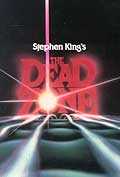 David Cronenberg's Unique Brand of 'Body' Horror:Subversive Canadian filmmaker David Cronenberg, known for disturbing sexual and 'body' horror with perennial themes of mutation and infection, made his directorial debut with his first major film Shivers (1975) (aka They Came From Within) about a group of Montreal high-rise apartment occupants on a sex and violence spree after being infected by parasites. His next notable film was Rabid (1977) starring ex-porn film star Marilyn Chambers with vampirish blood cravings following plastic surgery. Cronenberg's graphic The Brood (1979) depicted the birth of murderous demon-children from an insane mother. Scanners (1981) involved psychic, telepathic warriors with mental powers strong enough to explode heads.
David Cronenberg's Unique Brand of 'Body' Horror:Subversive Canadian filmmaker David Cronenberg, known for disturbing sexual and 'body' horror with perennial themes of mutation and infection, made his directorial debut with his first major film Shivers (1975) (aka They Came From Within) about a group of Montreal high-rise apartment occupants on a sex and violence spree after being infected by parasites. His next notable film was Rabid (1977) starring ex-porn film star Marilyn Chambers with vampirish blood cravings following plastic surgery. Cronenberg's graphic The Brood (1979) depicted the birth of murderous demon-children from an insane mother. Scanners (1981) involved psychic, telepathic warriors with mental powers strong enough to explode heads. Other exceptional films from Cronenberg in the 80s and 90s included an adaptation of Stephen King's novel The Dead Zone (1983), Videodrome (1983) - an ambiguous film about thought-control from a pirated satellite TV signal, The Fly (1986) starring Jeff Goldblum and Geena Davis - an effective re-make of the 1958 original. And then Cronenberg's most successful film, the frightening psychological thriller Dead Ringers (1988) featuring two Jeremy Irons and gynecological instruments, was followed by Naked Lunch (1991), the slickly original Crash (1995), and the alternate reality flick eXistenZ (1999). Recently, he directed A History of Violence (2005) about the after effects of violence upon the family of a small-town restaurant owner named Tom Stall (Viggo Mortensen), and featured William Hurt's frightening, unsettling Oscar-nominated 10-minute role as volatile mobster Richie Cusack.
Wes Craven:
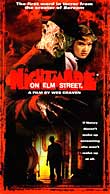 Wes Craven also began his career in violent horror films in the 70s, with the low-budget shocker Last House on the Left (1972) (a re-tooling of Ingmar Bergman's The Virgin Spring (1960)) and The Hills Have Eyes (1977) - about brutal, desert-dwelling, hillbilly mutant cannibals stalking a family in the wilderness. His two most famous films were teen slasher flicks that spurred a flurry of imitations and sequels:
Wes Craven also began his career in violent horror films in the 70s, with the low-budget shocker Last House on the Left (1972) (a re-tooling of Ingmar Bergman's The Virgin Spring (1960)) and The Hills Have Eyes (1977) - about brutal, desert-dwelling, hillbilly mutant cannibals stalking a family in the wilderness. His two most famous films were teen slasher flicks that spurred a flurry of imitations and sequels:- A Nightmare on Elm Street (1984) featuring Freddy Krueger (Robert Englund) as a re-incarnated child molester and serial killer with razor-fingered gloves and a burn-scarred face
- the surprising horror hit-spoof Scream (1996) that helped to reinvigorate films in the genre in the late 90s, with a slasher dressed as the Grim Reaper; it rejuvenated the slasher film in subsequent years
Scream's success brought about sequels in 1997 and 2000 - again with Neve Campbell as the terrorized teen and the few remaining characters from previous versions (Courteney Cox Arquette and David Arquette). The success of Scream was set up by his direction of the sequel Wes Craven's New Nightmare (1994), the 7th film in the series, with original star Heather Langenkamp, Craven himself, and Englund all playing themselves. In Red Eye (2005), his 20th feature film, Craven added to his horror repertoire this psychological thriller set on board an overnight jetliner flight to Miami, with Rachel McAdams as the terrified passenger Lisa Reisert taken 'hostage' by stranger/passenger Jackson Rippner (Cillian Murphy).
Blaxploitation Horror Films:
The first of the so-called exploitative 'blaxploitation' films (with predominantly African-American casts, music and themes) was Melvin Van Peebles' controversial independent film Sweet Sweetback's Baadasssss Song (1971). It jump-started a whole series of similar films about black private detectives and gritty urban life. As the movement progressed, it merged with the horror film genre (and others too, such as the sci-fi genre), and produced re-hashed hybrid films with blaxploitation content, often spoofing the titles of famous horror films from the past:
- William Crain's Blacula (1972) - with William Marshall as the accursed African prince title character terrorizing LA; and its sequel Scream, Blacula, Scream! (1973)
- The Thing with Two Heads (1972), a campy horror/comedy cult classic about a racist white mad scientist (Ray Milland) whose head has to be grafted onto the body of a huge black man (Rosie Grier)
- the sci-fi crime fantasy Top of the Heap (1972) - about a crazy young DC black cop fantasizing about being the first black man on the moon
- William Levey's notoriously trashy Frankenstein imitator Blackenstein (1973)
- Bill Gunn's Vampires of Harlem (1973), aka Ganja & Hess
- Voodoo Black Exorcist (1973, Sp.) aka Vudu sangriento
- William Girdler's Abby (1974) (a blaxploitation version of The Exorcist (1973))
- the kung-fu action film Black Belt Jones (1974)
- Black Werewolf/The Beast Must Die (1974)
- the zombie flick The House on Skull Mountain (1974)
- Ralph Bakshi's controversial animated film Coonskin (1975)
- Dr. Black, Mr. Hyde (1976)
- Abar, the First Black Superman (1977)
- The Six Thousand Dollar Nigger (1980)
Later blaxploitation films in the 90s with mostly horror themes included: Def by Temptation (1990), Candyman (1992) and its sequel Candyman: Farewell to the Flesh (1995), the western Posse (1993), Tales from the Hood (1995) (an anthology of 4 stories), Vampire in Brooklyn (1995) (a spoof starring Eddie Murphy), and Bones (2001) with rapper Snoop Dogg in the title role.
Horror in the 80s and 90s:
Many of the more successful horror films spawned inferior, low-budget, sickening slasher, 'schlock' or 'splatter' films in the 80s (and 90s). Most of these sequels or imitators were exploitative and featured shock, gory violence, graphic horror, 'teens in peril,' computer-generated special effects and makeup, and usually a homicidal male psycho who committed a progressive string of gruesome murders on female victims (where brutal killing/slashing/hacking metaphorically substituted for a rape). Many of these films told tales of a vengeful murderer motivated by some past misdeed or sexual perversity.
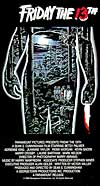 Friday the 13th (1980), the first of the horror genre's most recognizable horror series - with an astonishing number of sequels (ten), ripped off more original films of the 70s (such as director Mario Bava's definitive slasher/gore film A Bay of Blood (1971, It.) - R-rated) with tales of terrorized teen camp counselors. It also inspired a TV series and several spoofs. Jason, like the psychopathic Freddy Krueger before him in the Nightmare on Elm Street series, became a landmark name.
Friday the 13th (1980), the first of the horror genre's most recognizable horror series - with an astonishing number of sequels (ten), ripped off more original films of the 70s (such as director Mario Bava's definitive slasher/gore film A Bay of Blood (1971, It.) - R-rated) with tales of terrorized teen camp counselors. It also inspired a TV series and several spoofs. Jason, like the psychopathic Freddy Krueger before him in the Nightmare on Elm Street series, became a landmark name.- Friday the 13th (1980)
- Friday the 13th, Part 2 (1981)
- Friday the 13th, Part 3 (1982)
- Friday the 13th - The Final Chapter (1984)
- Friday the 13th Part V: A New Beginning (1985)
- Friday the 13th Part VI: Jason Lives (1986)
- Friday the 13th Part VII: The New Blood (1988)
- Friday the 13th Part VIII: Jason Takes Manhattan (1989)
- Jason Goes to Hell: The Final Friday (1993)
- Jason X (2002)
- Freddy vs. Jason (2003)
Child's Play (1988) was the first of a series of films about a bright, redheaded two foot-tall "Buddy" doll that was possessed by the soul and voice of evil and angry serial killer Charles Lee Ray (Brad Dourif) - it terrorized a young boy and his family. It was followed by two generic horror sequels in 1990 and 1991, and then Bride of Chucky (1998) that introduced a female serial killer doll Tiffany (voice of Jennifer Tilly) to infuse an element of black comedy. The fifth film in the series, Seed of Chucky (2004), directed by series screenwriter Don Mancini, was even more of a self-referencing horror/black comedy parody similar to Scream (1996), featuring numerous in-jokes (the gender-confused child of Chucky and Tiffany was named Glen/Glenda, a reference to the Ed Wood film; and Jennifer Tilly played herself, making references to her lesbian role in Bound (1996) with co-star Gina Gershon, etc.)
Fantasy Author H.P. Lovecraft and His Horror Tales:
Stuart Gordon's gory, cult-classic comedy about re-animated dead people, Re-Animator (1984) - was based on an H.P. Lovecraft serial tale, Herbert West—Reanimator. The twisted film was followed by additional sequels, also starring Jeffrey Combs as the demented medical student-turned experimental regenerator of dead bodies - Dr. Herbert West:
- The Bride of Animator (1990), d. Brian Yuzna
- Beyond Re-Animator (2003), d. Brian Yuzna
Another Lovecraft short story, From Beyond, was the basis of another Gordon/Yuzna collaboration, appropriately titled From Beyond (1986) - with the tagline "Humans Are Such Easy Prey", again featuring veterans Jeffrey Combs and Barbara Crampton. Many films have either been based upon or inspired by H.P. Lovecraft tales, such as the following:
- The Haunted Palace (1963) - from The Case of Charles Dexter Ward, from director Roger Corman - one of his "Poe" films; remade in 1991
- Die, Monster, Die! (1965, UK), aka Monster of Terror - from The Colour Out of Space; remade in 1987
- The Shuttered Room (1967, UK) - aka Blood Island - from The Shuttered Room
- The Crimson Cult (1968, UK), aka Curse of the Crimson Altar and The Crimson Altar - based on The Dreams in the Witch-House; featuring a late appearance by Boris Karloff
- The Dunwich Horror (1970) - from Lovecraft's own The Dunwich Horror; a Roger Corman-produced film
- The Curse (1987) - adapted from The Colour Out of Space
- The Unnamable (1988) - from The Unnamable
- The Resurrected (1991) - from The Case of Charles Dexter Ward
- The Unnamable II: The Statement of Randolph Carter (1992) - from The Statement of Randolph Carter
- Necronomicon (1993) - a triple anthology, based upon The Rats in the Walls, Cool Air, and The Whisperer in the Darkness; the Necronomicon was also featured in Sam Raimi's trilogy of Evil Dead films: The Evil Dead (1983), Evil Dead II: Dead by Dawn (1987), and Army of Darkness (1993)
- In the Mouth of Madness (1994) - from director John Carpenter; with Lovecraftian themes
- Lurking Fear (1994) - loosely based on The Lurking Fear
- Dagon (2001, Sp.) - based upon both Dagon and The Shadow Over Innsmouth
Sequel Horrors:
In many cases, sequels of popular titles were designed to cash in on an initial film's success: for example, all of these films cranked out sequels too numerous to mention: Halloween, Poltergeist, The Exorcist, It's Alive, A Nightmare on Elm Street, The Howling, Hellraiser, Darkman, Chucky, and Scream. Here are other examples of the decreased (or sometimes imitative, uninventive) quality of horror films beginning in the 80s: Mother's Day (1980), Motel Hell (1980), Prom Night (1980), He Knows You're Alone (1981), I Spit On Your Grave (1981), My Bloody Valentine (1981), the comedy parody Student Bodies (1981), and Sorority House Massacre (1986).
Sam Raimi:
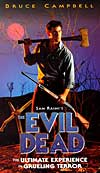 Writer/director Sam Raimi created some of the most exuberant, inventive, comic-book, tongue-in-cheek parodies with horror themes ever produced starring Bruce Campbell as the one-armed protagonist with a chain saw. The low-budget series began with The Evil Dead (1981) about a remote Tennessee cabin possessed by evil spirits and haunting five university students. It was followed by Evil Dead 2: Dead by Dawn (1987), and Army of Darkness (1992). Raimi's more mainstream film Darkman (1990) brought together elements of gothic horror and characters (the Invisible Man, the Wolf Man, and the Phantom of the Opera) and featured Liam Neeson as the tortured, vengeful, and disfigured scientist Peyton "Darkman" Westlake. He also directed the major blockbuster Spider-Man (2002) with the comic-book super-hero Spider-Man/Peter Parker (Tobey Maguire) battling his evil nemesis, the Green Goblin/Norman Osborn (Willem Dafoe). Director Raimi's sequel was equally successful both critically and at the box-office: Spider-Man 2 (2004) with a villainous Dr. Octopus (Alfred Molina).
Writer/director Sam Raimi created some of the most exuberant, inventive, comic-book, tongue-in-cheek parodies with horror themes ever produced starring Bruce Campbell as the one-armed protagonist with a chain saw. The low-budget series began with The Evil Dead (1981) about a remote Tennessee cabin possessed by evil spirits and haunting five university students. It was followed by Evil Dead 2: Dead by Dawn (1987), and Army of Darkness (1992). Raimi's more mainstream film Darkman (1990) brought together elements of gothic horror and characters (the Invisible Man, the Wolf Man, and the Phantom of the Opera) and featured Liam Neeson as the tortured, vengeful, and disfigured scientist Peyton "Darkman" Westlake. He also directed the major blockbuster Spider-Man (2002) with the comic-book super-hero Spider-Man/Peter Parker (Tobey Maguire) battling his evil nemesis, the Green Goblin/Norman Osborn (Willem Dafoe). Director Raimi's sequel was equally successful both critically and at the box-office: Spider-Man 2 (2004) with a villainous Dr. Octopus (Alfred Molina).Tim Burton:
Tim Burton contributed his unique and original vision to the horror genre with a number of imaginative films including the horror/comedy Beetlejuice (1988), two Batman films (the blockbuster original Batman (1989) and a sequel Batman Returns (1992)), the fantasy/horror film Edward Scissorhands (1990) about a boy/creature with blades for fingers, and the musical and macabre The Nightmare Before Christmas (1993) - with superb stop-motion animation in a tale about the saving of Christmas by Jack Skellington. Burton's biographical horror film Ed Wood (1994) included scenes with an aging Bela Lugosi (played by Oscar-winning Martin Landau), and his light-hearted, campy, escapist satire about Martian invaders titled Mars Attacks! (1996) spoofed disaster, science fiction, and monster films all at once. The famed director also retold and updated the famous Washington Irving legendary fable of The Headless Horseman in his Sleepy Hollow (1999) with Johnny Depp as Ichabod Crane.
Remakes of Classic Vampire, Wolfman, and Frankenstein Films in the 80s and 90s:
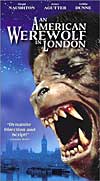 Classic Wolfman, Dracula/Vampire, and Frankenstein films were also resurrected and refashioned in the 80s and 90s with bigger budgets and stars. A few of the more accomplished but cliched horror films involving werewolves included John Landis' An American Werewolf in London (1981) (re-made as An American Werewolf in Paris (1997) in the setting of Paris), Joe Dante's horror/comedy The Howling (1981), and Mike Nichols' Wolf (1994) with Jack Nicholson as the afflicted individual - these films featured stunning metamorphosis sequences of man-into-wolf, elements that are now standard procedure for such films. Other recent werewolf films included: Michael Wadleigh's classic werewolf film Wolfen (1981), Neil Jordan's fairy tale-monster film The Company of Wolves (1984), Silver Bullet (1985) - an adaptation of Stephen King's Cycle of the Werewolf, the spoof Teen Wolf (1985) with Back to the Future's Michael J. Fox - and its sequel Teen Wolf Too (1987).
Classic Wolfman, Dracula/Vampire, and Frankenstein films were also resurrected and refashioned in the 80s and 90s with bigger budgets and stars. A few of the more accomplished but cliched horror films involving werewolves included John Landis' An American Werewolf in London (1981) (re-made as An American Werewolf in Paris (1997) in the setting of Paris), Joe Dante's horror/comedy The Howling (1981), and Mike Nichols' Wolf (1994) with Jack Nicholson as the afflicted individual - these films featured stunning metamorphosis sequences of man-into-wolf, elements that are now standard procedure for such films. Other recent werewolf films included: Michael Wadleigh's classic werewolf film Wolfen (1981), Neil Jordan's fairy tale-monster film The Company of Wolves (1984), Silver Bullet (1985) - an adaptation of Stephen King's Cycle of the Werewolf, the spoof Teen Wolf (1985) with Back to the Future's Michael J. Fox - and its sequel Teen Wolf Too (1987).Frank Langella recreated his Broadway role and starred as the famed but tragically-anguished Count in Dracula (1979), and in the same year, the vampire myth was spoofed in the campy Love at First Bite (1979) with George Hamilton. And then Tony Scott filmed the glossy lesbian/vampire tale The Hunger (1983) that starred Catherine Deneuve and Susan Sarandon. The campy teen/horror spoof Buffy the Vampire Slayer (1992) cast Kristy Swanson as the improbable cheerleader and Valley Girl mall queen chosen to challenge LA vampires. The popular TV series of the same name, with high-school vampire slayer Buffy Summers (Sarah Michelle Gellar) perpetuated the vampire myth - it was set in her hometown of Sunnydale, conveniently located above the Hellmouth.
Writer/director Stephen Sommers resurrected The Mummy as a horror creature in his two cliff-hanger Mummy action films: The Mummy (1999) and The Mummy Returns (2001), starring Brendan Fraser as the character of legionnaire Rick O'Connell - a take-off on Indiana Jones, with a pretty but inept Egyptologist archaeologist Evelyn Carnahan (Rachel Weisz), and the 3,000-year-old mummified corpse of vengeful high priest Imhotep (Arnold Vosloo). The series' third film, The Mummy: Tomb of the Dragon Emperor (2008), directed by Rob Cohen (but produced by franchise founder Stephen Sommers), focused on the resurrected terra cotta "mummy" of evil and ruthless Dragon Emperor Han (Jet Li), as the series moved to the Far East and China. The film co-starred Michelle Yeoh (as ancient witch Zi Juan) and Maria Bello replaced Weisz in the role of Evelyn. A spin-off character from The Mummy Returns (2001), the Scorpion King, appeared in another film, Chuck Russell's The Scorpion King (2002), with professional wrestler Dwayne 'The Rock' Johnson in the title role. Sommers also wrote and directed the big-budget Van Helsing (2004), featuring Hugh Jackman as the legendary monster hunter who battles not one but three classic creatures: The Wolf Man, Count Dracula and Frankenstein's Monster. The film contained compelling CG special effects, including three half-naked vampires.
0 yorum:
Yorum Gönder